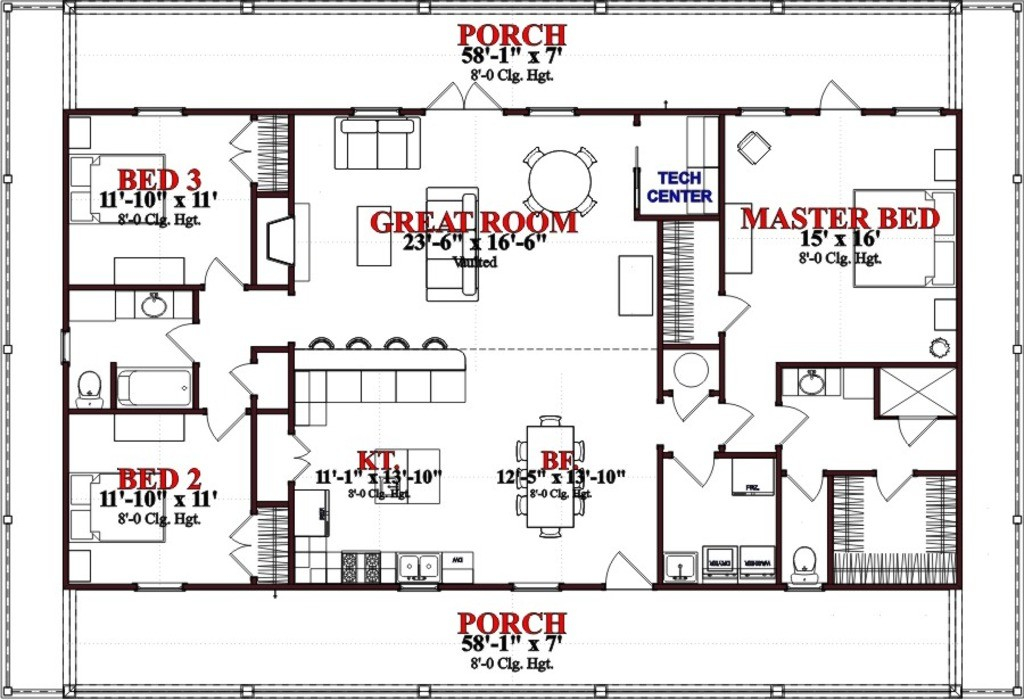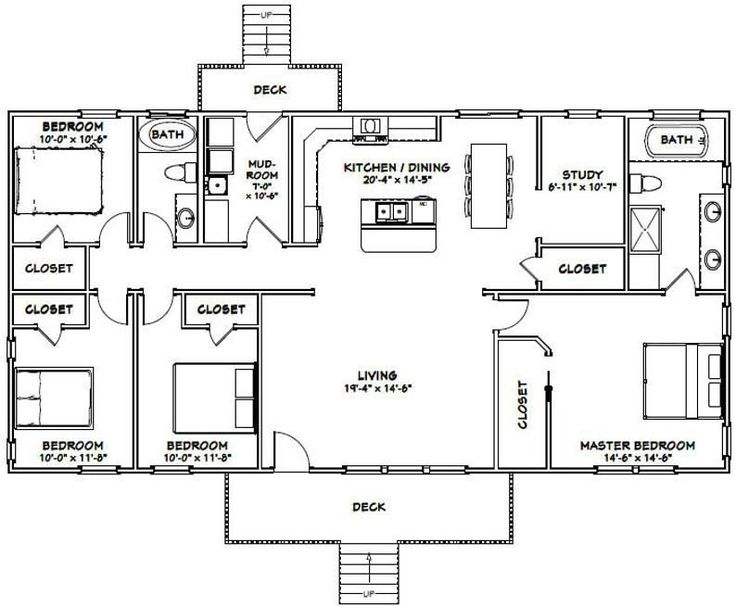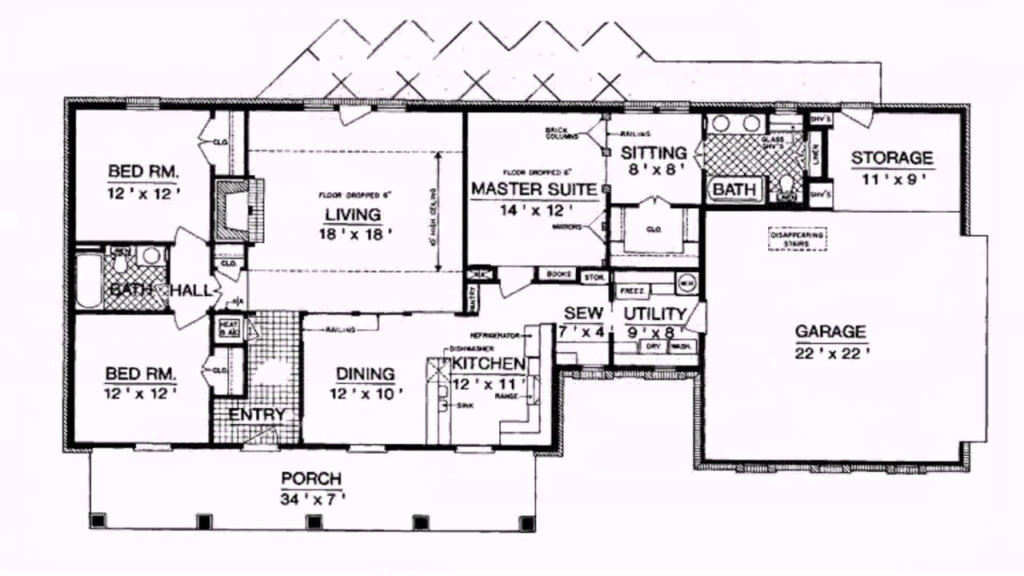1800 SQ FT House Plans No Garage – Building a home is not nearly wall surfaces and roofs– it has to do with developing a space where memories are made, where every edge serves a objective, and where you can really feel comfy and unwinded. When it comes to preparing your new home, one of the most critical elements you’ll need to think about is square footage (SQ FT). Understanding exactly how square video footage impacts your home’s design can aid you make better choices, whether you’re going with a compact yet efficient design or a large, multi-story manor. Allow’s study just how square footage influences your home planning procedure. 1800 SQ FT House Plans No Garage.
What are SQ FT House Plans?
SQ FT home prepares describe the dimension of the complete area in a residence, typically broken down right into different rooms and areas. Square video footage is a vital factor in determining the general feeling of a house, influencing whatever from room dimensions to web traffic circulation and even power performance. By understanding square footage, you can select a plan that fits both your requirements and your budget plan.
Why Square Footage Issues in House Design
Square footage matters since it straight affects how much usable area you’ll have in your home. Bigger homes often tend to have more space for amenities like walk-in storage rooms, extensive cooking areas, and guest rooms, while smaller sized homes focus on effective use of room. The best square video footage allows you to balance convenience and capability without really feeling overwhelmed by unused space or confined quarters.
Recognizing Square Footage in Home Strategies
What Does Square Video Mean?
Square video is the dimension of a home’s indoor area. It’s determined by multiplying the length and size of a room (in feet). This number helps to provide a sense of how much area you’ll have for day-to-day activities, consisting of food preparation, eating, resting, and relaxing.
How is SQ FT Measured?
To figure out the square video footage of a home, you’ll normally measure the exterior walls of the home and multiply the length by the width. Common locations like living spaces, kitchens, bedrooms, and hallways are consisted of, however areas like garages, outdoor patios, or verandas could not constantly be taken into consideration in the last SQ FT total, depending upon the style.
Usual Terms Associated with Square Footage
When searching residence plans, you may find terms such as:
- Gross Square Footage: The total area, including walls and shared rooms.
- Net Square Footage: The real usable area of the home, excluding walls, corridors, and other non-livable spaces.
- Completed vs. Incomplete SQ FT: Ended up SQ FT refers to areas that are habitable and furnished with all needed functions, while incomplete spaces like basements might be included in larger SQ FT totals however aren’t always useful without extra work.
How Square Footage Affects Residence Strategies
The Connection Between Area and Performance
The square footage you select affects how easily a residence can suit your family members’s way of living. For instance, a larger home permits more customized areas (like a dedicated home office, health club, or media room), whereas a smaller home may encourage you to concentrate on multifunctional rooms that offer several objectives.
Changing SQ FT for Various Household Sizes
Bigger family members usually require more room to maintain everyone comfortable. A higher square video footage can give numerous bedrooms, washrooms, and living areas that deal with everyone’s demands. Alternatively, smaller households might locate that portable homes with effective layouts provide more than enough area without the included concern of keeping a sprawling building.
Choosing the Right SQ FT for Your Way of living
It is essential to think about how much area you really need, based upon how you and your family hang around at home. If you amuse commonly, a larger living and eating location may be needed. If you value minimalism, a smaller home may be a much better fit, providing simplicity and reduced maintenance.
Popular SQ FT Ranges for Home Plans
Tiny Residences: Under 1,500 SQ FT.
Tiny homes generally vary from 600 to 1,500 square feet. They’re ideal for singles, couples, or little families that like a less complex, much more affordable space. These homes concentrate on reliable design, maximizing every inch of area for optimum performance.
Medium Homes: 1,500 to 2,500 SQ FT.
Homes in this variety commonly suit expanding family members or those that desire a bit even more area without overdoing it. They usually feature several bed rooms and washrooms, a bigger kitchen area, and a lot more storage room. Medium-sized homes give a excellent balance in between affordability and convenience.
Large Homes: 2,500 to 4,000+ SQ FT.
Big homes provide enough area for households that require different spaces for every person, plus additional space like office, collections, or guest rooms. While they can be pricey to build and maintain, they use an abundance of adaptability and high-end.
Factors to Think About When Choosing SQ FT for Your Home.
Spending plan and Affordability.
The square video footage of your home will certainly have a direct effect on your spending plan. Bigger homes require more building products and might feature greater power expenses, while smaller homes can aid you save money in the long run.
Future Development Possible.
Consider your family members’s lasting requirements. Do you prepare to expand in the future? If so, you could wish to choose a floor plan that permits easy enhancements or adjustments in the future.
Upkeep and Upkeep.
A larger home indicates even more room to clean and maintain, whereas a smaller sized home is commonly more manageable. Consider just how much effort and time you want to take into keeping your home in top shape.
Energy Effectiveness Considerations.
Bigger homes normally utilize much more energy, so be sure to consider heating, cooling, and electricity prices. Search for energy-efficient designs or consider methods to reduce power consumption with clever home innovation.
Types of Home Program Based on Square Video.
One-Story Homes.
One-story homes are fantastic for those that desire every little thing on one degree, supplying very easy access to all locations of the house. They often tend to be much more obtainable, making them excellent for those with flexibility problems or children.
Multi-Story Residences.
Multi-story homes allow you to spread out in a smaller impact. These homes are perfect for families that intend to make best use of area on smaller sized stories of land, offering the advantage of separate home on various floorings.
Open Principle vs. Typical Floor Plans.
Open principle layout function big, streaming spaces where the cooking area, living, and eating locations are effortlessly linked. These strategies are typically found in medium and big homes and accommodate contemporary, social living. Typical floor plans, nevertheless, separate each area for even more privacy.
How to Optimize Your Space in Smaller Sized Homes.
- Smart Storage Solutions: In little homes, storage space is vital. Use under-the-bed storage space, integrated racks, and multi-purpose furniture to maintain your space tidy and effective.
- Open Up Layout: Open layout enable far better flow and can make smaller homes really feel larger. Eliminating unnecessary walls can produce a sense of area while supplying a modern-day visual.
- Multi-Purpose Spaces: Turn one area right into a multi-functional space. For example, a visitor bed room can double as a home office or workout space.
The Advantages of Larger Residences.
- More Space for Family Members and Guests: Huge homes are excellent for households with children or frequent visitors. With numerous bedrooms, living locations, and bathrooms, everyone can enjoy their own room.
- Versatility in Area Use: In larger homes, spaces can offer multiple purposes, such as a home office, game room, or gym.
- Enhanced Privacy: With more square video, it’s easier to make a home that uses privacy for every family member, making it ideal for those who like space from one another.
Picking In Between Custom vs. Pre-Designed Residence Strategies.
- Pros and Cons of Custom Plans: Custom home strategies are tailored to your certain requirements yet can be much more costly and taxing. They allow for adaptability yet might involve extra decisions.
- The Ease of Pre-Designed Options: Pre-designed strategies are quicker to apply and frequently come at a lower price. Nonetheless, they may not totally reflect your choices, needing compromises in design.
How to Determine Square Footage for Your Own Plans.
- Steps for Accurate SQ FT Calculation: Adhere to these actions to measure your square footage: Action each area’s size and size, increase them together, and add up the total amounts for every space.
- Tools and Software for House Strategy Design: There are different design tools and software program readily available to aid you prepare your home successfully. Programs like SketchUp and AutoCAD permit in-depth floor plan design.
The Significance of Circulation and Format.
- Creating Functional Website Traffic Patterns: Web traffic circulation refers to how quickly you can move from space to space. A well-designed layout ensures that rooms are logically positioned and simple to browse.
- Designing for Comfort and Ease of Living: The layout ought to additionally focus on convenience. From bedroom locations to kitchen placement, the style must make day-to-day live as seamless as possible.
Patterns in SQ FT Home Plans.
- Eco-Friendly and Sustainable Layouts: Eco-conscious property owners are significantly selecting smaller sized, energy-efficient homes made from lasting materials. These designs prioritize ecological impact while maximizing area.
- Smart Home Assimilation: Many contemporary home plans now consist of rooms for clever home innovation. From energy-efficient home appliances to safety systems, incorporating technology into your residence strategy is ending up being a must.
Final thought.
Picking the appropriate square video for your home is a crucial decision that will certainly shape your living experience. Whether you select a small, reliable home or a large, extravagant one, it’s important to consider your way of life, budget plan, and long-term goals when making this selection. Take some time to examine all variables, including performance, style, and future demands, and keep in mind– even more room doesn’t constantly suggest better living!


